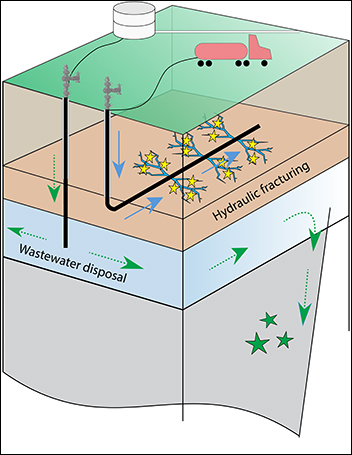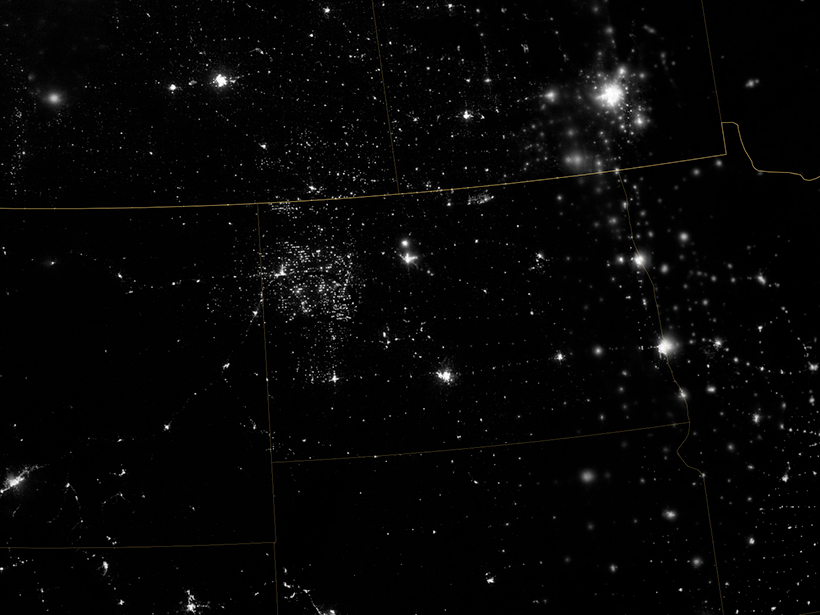Source: Journal of Geophysical Research: Solid Earth
Human activities that change stresses in Earth’s surface—like hydraulic fracturing (or fracking) and wastewater disposal—are known to cause earthquakes, even in areas where earthquakes are not historically common. In hydraulic fracturing, a slurry of water, sand, and chemicals is pumped through the ground at high pressures, cracking open rocks to release oil and natural gas. This produces tiny earthquakes that usually can’t be detected without sensitive instrumentation. Disposing of wastewater by injecting it into the crust can also trigger quakes: As the increased fluid pressure migrates away from the well, it can reach a well-oriented fault that is close to breaking and cause it to slip. Since these deeper faults are often larger, they are capable of producing larger earthquakes. Understanding the relationship between these processes and earthquakes is crucial to mitigating seismic hazards.
To assess this connection, Yoon et al. zeroed in on a sequence of earthquakes that occurred in central Arkansas between 2010 and 2011. At that time, several companies were extracting natural gas from the Fayetteville Shale, one of the largest gas fields in the country.
Soon after wastewater injection began in July 2010, scientists started to detect seismic activity in the surrounding region, which led to a series of felt earthquakes. When a magnitude 4.7 earthquake struck on 27 February 2011, the Arkansas Oil and Gas Commission issued an emergency order to stop all wastewater injection. After that, seismicity decreased, but, for months afterward, still remained higher than the historical rates.

To understand how this earthquake sequence got started, the researchers analyzed seismic activity in the area before the quake, between June and September 2010. Since Arkansas has only a few instruments to record ground shaking, they used an advanced data mining algorithm inspired by the Shazam music recognition app to detect the 1,740 largest quakes, which formed 16 tight clusters. They compared these data to public records on wastewater injection and fracking activity in the area.

Although a small number of these earthquakes correlated with wastewater injection, the vast majority correlated with fracking operations at 17 out of 53 nearby production wells active during this time. Compared to quakes typically caused by fracking, these events were bigger, more numerous, longer lasting, and farther away from the well—all indicating a high level of stress in the area. Deeper, larger faults would also have been highly stressed and unstable, easily prone to slipping and generating felt earthquakes greater than magnitude 4.
This study bolsters the case that earthquakes are triggered not only by wastewater disposal but also by hydraulic fracturing. It also demonstrates how sensitive, efficient, cost-effective monitoring techniques—inspired by new data mining technologies—can help scientists understand the big picture of earthquake activity. Continuous monitoring before, during, and after fracking and wastewater injection could offer new information to help shape policy aimed at reducing earthquake hazards. (Journal of Geophysical Research: Solid Earth, https://doi.org/10.1002/2017JB014946, 2017)
—Sarah Witman, Freelance Writer
Citation:
Witman, S. (2018), More earthquakes may be the result of fracking than we thought, Eos, 99, https://doi.org/10.1029/2018EO091727. Published on 08 February 2018.
Text © 2018. The authors. CC BY-NC-ND 3.0
Except where otherwise noted, images are subject to copyright. Any reuse without express permission from the copyright owner is prohibited.

